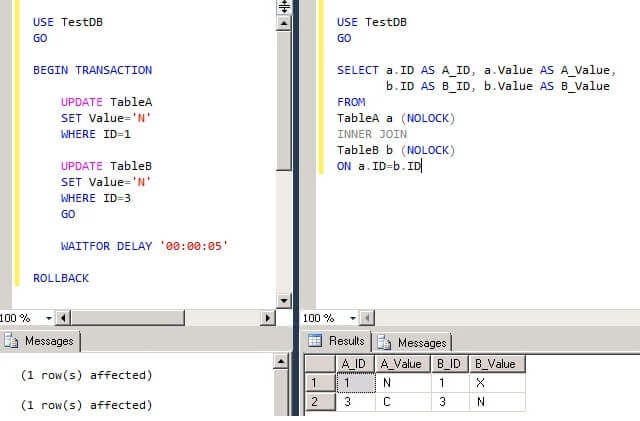

I went on a job interview once where they didn't hire me because I didn’t “know” that you should always NOLOCK.I believe I also mentioned that the need to use NOLOCK in a production application was a sure sign of a badly done application. trouble since 1980Blog: up SSMS development: <- version 1.0 out! All ForumsĬomments in this post show some true misunderstandings of locking in sql server.

We've got lots of great SQL ServerĮxperts to answer whatever question you can come up with. I hope that now users are clear on with nolock in SQL as well as no lock in SQL server DB. It is possible with With (Nolock) that, it can read an uncommitted transaction, which can be rolled back in the middle of a read. While With nolock in SQL does not issue any shared locks or exclusive locks. Thus, we can say that Nolock reads “Dirty Data” when applied with only the Select statement in SQL Server Database. ConclusionĪs we can see the difference between Nolock and With (Nolock) is that, the Nolock reads that data, which has not been committed and can be rolled back. But, using WITH (nolock) could be unsafe, because it will return inconsistent results. The Readuncommited and WITH (nolock) are similar to the transaction isolation level. However, you can use with nolock in SQL along with single or subqueries. While using WITH (nolock) there is no need to do anything with subqueries. The benefit of using With Nolock is that no deadlock is encountered against the table’s queries running against the table also, there is no need to hold the locks against the data, which will save memory space. It does not use locks against table’s data, once the command is issued. This directly specifies a particular table or a view & is similar to Nolock hint. When we talk about SQL with nolock, we can say that it is an explicit command. The above statement for NOLOCK in SQL returns 10 records, so we can understand that the Nolock intimates to keep the database engine from issuing locks against the tables. SELECT COUNT(*) FROM Test Table WITH(NOLOCK) To check the changes we can execute the select statement: The Rollback Transaction statement removes the record from the test table.

This is a key element in understanding nolock vs with nolock in depth. This means I can still roll back the inserted transactions by executing the command given below in the query window.

The NOLOCK in SQL Server select statement returns 11 records, so the transaction that I inserted in the test table is still not committed. SELECT COUNT(*) FROM testtable WITH(NOLOCK) Now, in the other query window, execute the below query with the no lock in SQL table hint to check for the record inserted in it. We can take an example to see how Nolock works: BEGIN TRANSACTIONĪfter inserting a record into the test table we can see that the table still has locks issued against it. It specifies that no shared locks can be issued against the table, which prevents other transactions from modifying the data in a table. Its major function is to allow users to view data while bypassing any type of lock to not get blocked. The NOLOCK in SQL Server can also be called READUNCOMMITTED.


 0 kommentar(er)
0 kommentar(er)
